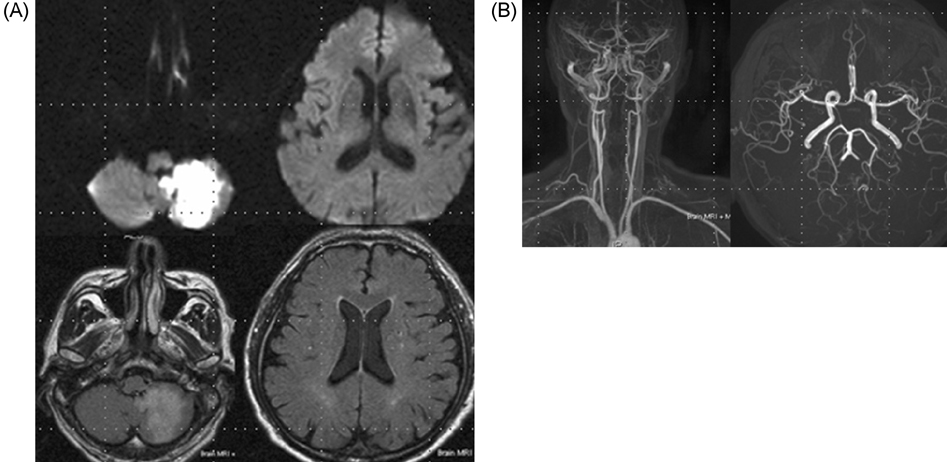J Clin Neurol.
2007 Dec;3(4):192-196. 10.3988/jcn.2007.3.4.192.
Akinetic Mutism and Cognitive-Affective Syndrome Caused by Unilateral PICA Infarction
- Affiliations
-
- 1Department of Neurology, Seoul National University College of Medicine, Seoul, and Seoul National University Bundang Hospital, Gyeonggi-do, Korea. neuroksy@snu.ac.kr
- 2Department of neurology, Konyang University Hospital, Daejeon, Korea.
- 3Department of neurology, Cheju National University College of Medicine, Jeju, Korea.
- KMID: 1808554
- DOI: http://doi.org/10.3988/jcn.2007.3.4.192
Abstract
- A 42-year-old man with left posterior inferior cerebellar artery (PICA) infarction presented with akinetic mutism and cognitive impairment. Initially he suffered from akinetic mutism and MRI-documented infarction in the distribution of the left PICA. Twelve days later he developed cognitive impairment. Neuropsychological tests were performed, with the results corrected for age and education being compared with published Korean norms. Impaired performances were evident on executive function testing, with difficulties in planning, abstract reasoning, set-shifting, and perseveration. Akinetic mutism and cognitive-affective syndrome may be a manifestation of unilateral PICA infarction.
Keyword
MeSH Terms
Figure
Cited by 2 articles
-
Cognitive Impairment in Essential Tremor without Dementia
Joong-Seok Kim, In-Uk Song, Yong-Soo Shim, Jeong-Wook Park, Ji-Yeon Yoo, Yeong-In Kim, Kwang-Soo Lee
J Clin Neurol. 2009;5(2):81-84. doi: 10.3988/jcn.2009.5.2.81.Spinocerebellar Ataxia Type 2 with Only Clinical Feature of Memory Impairment: Case Report
JaeJeong Joo, Sang Wo Han, Sang Won Ha, Jeong Ho Han, Doo Eung Kim, YoungSoon Yang
Dement Neurocogn Disord. 2014;13(1):16-19. doi: 10.12779/dnd.2014.13.1.16.
Reference
-
1. Ackerman H, Ziegler W. Akinetic mutism - a review of the literature. Fortschr Neurol Psychiatr. 1995. 63:59–67.2. Celesia GG. Persistent vegetative state: clinical and ethical issues. Theor Med. 1997. 18:221–236.3. American Congress. Recommendations for use of uniform nomenclature pertinent to patients with severe alterations in consciousness. Arch Phys Med Rehabil. 1995. 76:205–209.
Article4. Cairns H, Oldfield RC, Pennybacker JB, Whitteridge D. Akinetic mutism with an epidermoid cyst of the 3rd ventricle. Brain. 1941. 64:273–290.
Article5. Yamanaka K, Fukuyama H, Kimura J. Abulia from unilateral capsular genu infarction: report of two cases. J Neurol Sci. 1996. 143:181–184.
Article6. Riva C, Giorgi C. The cerebellum contributes to higher functions during development: evidence from a series of children surgically treated for posterior fossa tumours. Brain. 2000. 123:1051–1061.
Article7. Schmahmann JD, Sherman JC. The cerebellar cognitive affective syndrome. Brain. 1998. 121:561–579.
Article8. Mega MS, Cohenour RC. Akinetic mutism: disconnection of frontal-subcortical circuits. Neuropsychiatry Neuropsychol Behav Neurol. 1997. 10:254–259.9. Grasby PM, Frith CD, Friston KJ, Bench C, Frackowiak RSJ, Dolan RJ. Functional mapping of brain areas implicated in auditory - verbal memory function. Brain. 1993. 116:1–20.
Article10. Fiez JA, Petersen SE, Cheney MK, Raichle ME. Impaired non-motor learning and error detection associated with cerebellar damage. A single case study. Brain. 1992. 115:155–178.
Article11. Drepper J, Timmann D, Kolb FP, Diener HC. Nonmotor associative learning in patients with isolated degenerative cerebellar disease. Brain. 1999. 122:87–97.
Article12. Appollonio IM, Grafman J, Schwartz V, Massaquoi S, Hallett M. Memory in patients with cerebellar degeneration. Neurology. 1993. 43:1536–1544.
Article13. Leiner HC, Leiner AL, Dow RS. Cerebro-cerebellar learning loops in apes and humans. Ital J Neurol Sci. 1987. 8:425–436.
Article14. Middleton FA, Strick PL. Anatomical evidence for cerebellar and basal ganglia involvement in higher cognitive function. Science. 1994. 266:458–461.
Article15. Schmahmann JD, Pandya DN. The cerebrocerebellar system. Int Rev Neurobiol. 1997. 41:31–60.
Article16. Vokaer M, Bier JC, Elincx S, Claes T, Paquier P, Goldman S, et al. The cerebellum may be directly involved in cognitive functions. Neurology. 2002. 58:967–970.
Article17. Ivry RB, Fiez JA. Gazzaniga MS, editor. Cerebellar contributions to cognition and imagery. The new cognitive neuroscience. 2000. London: MIT Press;999–1011.18. Mewasingh LD, Khadim H, Christophe C, Christiaens FJ, Dan B. Nonsurgical cerebellar mutism (anarthria) in two children. Pediatr Neurol. 2003. 28:59–63.
Article19. Rekate HL, Grubb RL, Aram DM, Hahn JF, Ratcheson RA. Muteness of cerebellar origin. Arch Neurol. 1985. 42:697–698.
Article20. Al-Anazi A, Hassounah M, Sheikh B, Barayan S. Cerebellar mutism caused by arteriovenous malformation of the vermis. Br J Neurosurg. 2001. 15:47–50.
Article
- Full Text Links
- Actions
-
Cited
- CITED
-
- Close
- Share
- Similar articles
-
- The Effect of Levodopa on Akinetic Mutism in Bilateral Anterior Cerebral Artery Infarction: A case report
- A Case of Akinetic Mutism Caused by Volume Change of Cerebral Ventricles
- Akinetic Mutism from Obstructive Hydrocephalus;Successful Treatment with Bromocriptine and Ephedrine
- Transient Akinetic Mutism Following General Anesthesia: A case report
- A Case of Cerebromedullospinal Disconnection: The 'Locked-In' Syndrome



